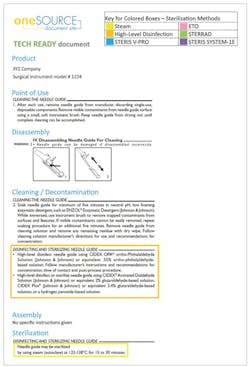Infection preventionists (IPs) have many distinctive roles such as professional standards expert, mentor, leader, collaborator, healthcare associated infections (HAIs) expert and consultant. All of these roles are aimed at prevention of infections. As Denise Cardo, MD, Director of CDC’s Division of Healthcare Quality Promotion states, IPs and epidemiologists are very unique because they know what is happening in their facility via data they have collected, and they have the knowledge of what needs to be done to prevent infections.1
It takes a village
IPs cannot reduce the risks of HAIs alone. It takes a village, meaning the entire healthcare team owns a part of infection prevention. No matter what the role, as healthcare providers we must decrease patient risks by improving quality of care throughout the organization.
Many HAIs, especially surgical site infections (SSIs) are preventable. Knowing and following the most current evidence-based professional published standards and guidelines are a major step in SSI prevention. Over the years IPs have been very instrumental in helping their facilites reduce the dependence on and abuse of Immediate Use Steam Sterilization (IUSS), formerly called flash sterilization. Now there is another patient risk that Sterile Processing (SP) and the Operating Room (OR) will need IPs to help with – the issue of not following the specific manufacturer’s instructions for use (IFU) with sterilization and/or high-level disinfection (HLD).
Adhere to instructions for use
Many reusable devices pose great risks of transmitting infections (e.g., endoscopes, arthroscopes, laparoscopic instrumentation) or pose a real challenge to adequate reprocessing (e.g., long narrow or multiple lumens, hinges, stopcocks etc.) therefore, it is imperative that the IFUs for instruments, equipment, chemicals etc. are followed.
Before a manufacturer can take a reusable product to market they must apply to the Food and Drug Administration (FDA) for a 510(k) clearance. “A 510(K) is a premarket submission made to FDA to demonstrate that the device to be marketed is at least as safe and effective, that is, substantially equivalent, to a legally marketed device (21 CFR §807.92(a)(3)) that is not subject to premarket approval.”2 Part of the obligations for the clearance process of reusable devices is labeling claims that must include validation data regarding cleaning, disinfection and sterilization.
Professional organizations, for example the Centers for Disease Control and Prevention (CDC), the Association for Professionals in Infection Control and Epidemiology (APIC), the Association of periOperative Registered Nurses (AORN), the Association for the Advancement of Medical Instrumentation (AAMI) etc., all state we must follow the manufacturer’s IFUs. However, in my experience as a consultant to IP, SP and OR, many facilites are not routinely following the specific manufacturers’ IFU for the instruments, equipment and chemicals. Instead, they are using the old method of “it’s how we have always done it.” In our efforts to improve processes and reduce patient risks we must follow the validated IFUs. AAMI defines IFUs as: Written recommendations provided by the manufacturer that provide instructions for operation and safe and effective use of its device.3
Write policies to evidence-based guidelines
According to the Joint Commission (TJC) standard IC.01.05.01 – Facilities must use evidence-based guidelines and standards (EBG) when developing infection prevention and control activities.4 In TJC’s October 30, 2018 webinar titled Disinfection and Sterilization: Dispelling the Myths, Sylvia Garcia-Houchins, RN, MBA, CIC – Director, Infection Prevention and Control, stated “Facilities should be able to articulate the source of their IC practices if they are based on multiple EBG, for example a facility might choose:
- AORN for dress code and aseptic practices in the OR
- AAMI for reprocessing of sterile instruments and endoscopes, or
- CDC for isolation practices in oncology clinics.”4
It is essential to have access to the most current, validated manufacturers’ IFU documents for facilitating safe and effective reprocessing of medical devices and equipment. These items could pose a very real threat to the health and safety of both patients and staff if processes are not carried out in accordance with the procedures outlined in the manufacturer’s validated IFU.5
Organization-wide solution
Healthcare facilities should have access to the most current manufacturers’ IFU via electronic documents or hard copy. The latter is very hard to maintain, especially keeping up with what is the most current IFUs, having space to store the enormous amounts of documents and having them readily available to the frontline workers, including those working in decontamination areas. Most products are marketed in multiple countries; therefore, the IFUs are in many different languages, and in very small font to reduce the amount of paper used in the packaging. This also makes it very difficult to find the specific information you are looking for (e.g., how to clean, sterilize, etc.).
Fortunately, there is an easier solution – subscribing to an electronic online database service of manufacturers’ validated IFUs. Having an online database of IFUs allows employees to access the documents at a click of a mouse. The IFUs are electronically kept up to date. This allows everyone in the organization (SP, the OR, IP, risk management (RM), etc.) a way to quickly access the most current IFUs and be in compliance with EBG and accreditations standards such as TJC.
In addition to having fast and easy facility-wide access, the online electronic database provides a snapshot of all applicable cleaning, decontamination, assembly, disinfection and sterilization parameters from the original IFU which is often buried amongst the vast amount of other information necessary for marketing. The step-by-step snapshot (e.g., tech-ready documents) provides real time and money-saving solutions.6
IPs need to be involved in creating policies and procedures (P&P) related to sterilization and HLD. Written P&Ps should follow current EBG written by professional organizations. Well informed IPs are very instrumental in influencing change within their organization, especially if that change means reducing patient risks of HAIs by improving processes and simplifying procedures. If your organization does not currently have access to an electronic online database of IFUs for sterilization I highly recommend IPs work with SP, OR and RM to encourage your organization to subscribe to the online database service of manufacturer’s IFU documents to help ensure sterilization and HLD compliance and therefore reduce risks of HAIs.
References
- 1California Department of Public Health. The Role of the Infection Preventionist. Available at: https://www.cdph.ca.gov/Programs/CHCQ/HAI/CDPH%20Document%20Library/1_Role_of_IP_Approved10.9.17.pdf. Accessed 1/20/2019.
- U.S. Food and Drug Administration. 510(k) Premarket Notification. Available at: https://www.accessdata.fda.gov/scripts/cdrh/cfdocs/cfPMN/pmn.cfm. Accessed 1/20/2019.
- ST79 – Comprehensive guide to steam sterilization and sterility assurance in health care facilities, ANSI/AAMI ST79:2017.
- Garcia-Huchins, S. Disinfection and Sterilization: Dispelling the Myths – webinar. Available at: https://www.jointcommission.org/disinfection_and_sterilization_dispelling_myths/ Accessed 1/21/2019.
- Efficient Management of Manufacturers’ Instructions For Use (IFU) Documents. Available at: https://www.onesourcedocs.com/white-paper-download.html. Accessed 1/20/2019.
- Technician-Ready Docs / Step-by-Step Snapshots – OneSource Docs. Available at: https://www.onesourcedocs.com/biomed/tech-ready-documents.html. Accessed 1/22/2019.
About the Author

Rose Seavey
Rose Seavey MBA, BS, RN, CNOR, CRCST, CSPDT, is an Educational Consultant to 3M Health Care. Ms. Seavey is President/CEO of Seavey Healthcare Consulting. Ms. Seavey is the 2019 recipient of the AAMI Standards Developer Award. Ms. Seavey is the author of the book tilted Sterile Processing in Healthcare Facilities: Preparing for Accreditation Surveys, published by AAMI, now in its third edition.

